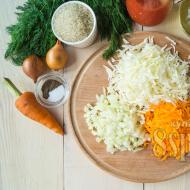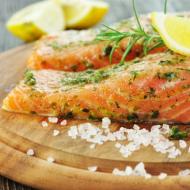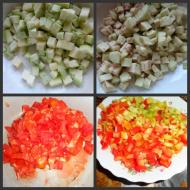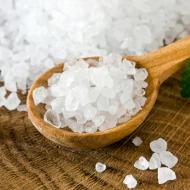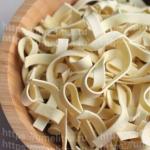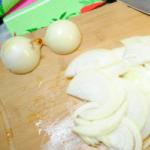
How to cook lightly salted fish at home. Brine for fish: preparation options. How to salt fish at home. In the freezer
How to salt red fish at home: recipes, the advantages of a homemade delicacy over a store-bought product, subtleties and methods of preparing it.
Red fish can be either an independent dish or a noble appetizer. Its most delicious varieties are salmon, trout, sockeye salmon, pink salmon, chum salmon, nelma and white fish. And they are most useful after cold smoking or home pickling.
Homemade salting of red fish has undeniable advantages:
- the resulting meat is very tender, which retains its natural advantages and beneficial properties, which cannot be said about a store-bought product: it usually contains a lot of salt and also contains preservatives;
- Red fish cannot be spoiled by salting: the meat of these aquatic inhabitants will take exactly as much salt as needed; excess salt simply will not be absorbed.
But how to properly and tasty salt red fish at home? What breed of fish family should I buy? Which salting method should I choose? We will tell you about all this in detail.
1. Buying fish
The most crucial moment is the purchase of the “hero of the occasion”: it must be fresh and uncut; you need a whole fish carcass, chilled or frozen. The most tender meat is found in salmon, sockeye salmon and trout. But chum salmon and pink salmon may turn out a little dry; When salting, it is advisable to season them with olive oil. In addition, salmon and trout are larger fish: their fillet pieces look much more beautiful when cut.
2. Preparation for salting
You will need a sharp cutting knife, a pickling mixture, culinary scissors and a fish container. An enamel saucepan or plastic container will do. It is better not to use metal dishes, because brine is an aggressive environment: after being in such a container, the fish may develop an unpleasant “iron” taste. You need to defrost the carcass naturally, at room temperature.
3. Fish cutting
Use a knife to cut off the head of the fish, and cut off the fins with culinary scissors. Cut the belly lengthwise and remove all the entrails. If you find caviar inside, you need to carefully remove it, remove the film, treat it with boiling water for disinfection and place it in salted water for 10 minutes (2 tablespoons of salt per 0.5 liter of warm (!) water). If you find milk inside, carefully rinse it and salt it along with the carcass.
But let's get back to the fish. After you have freed the belly from the entrails, you need to clean the fish from the bones. Using scissors, make cuts to the right and left of the spine to separate it from the rest of the bones: they can then be easily removed by hand. If the carcass is large, you can cut it in half.
4. Preparation of the mixture for pickling
The mixture for salting fish is prepared from salt and sugar. For 1 kg of meat you will need about 3 tablespoons of the mixture. The salt should be coarsely ground; it will allow the fish to salt in its own juice. If desired, you can use other spices: bay leaf (3-4 pieces per carcass), allspice peas, mustard, crushed coriander, any greens, aromatic herbs - whatever you like; but even without them, red fish will turn out very tasty. An improvised oppression will also work - for example, a jar filled with water: a plate is placed on the fish placed in a bowl, and a weight is placed on it that will press the meat. To make it easier to cut the fish after salting, you need to lightly freeze it.
5. Salting red fish: recipes
Recipe 1. Red fish under pressure
You will need: 1 kg of fish, 2 tablespoons of salt, 1 tablespoon of granulated sugar.
Mix salt and sugar, thoroughly rub the carcass with the resulting mixture, place it in a bowl, build a pressure and let the fish “rest” for a couple of hours in a warm place. Then the carcass will need to be cleaned of excess salt and placed in the refrigerator for a day.
Recipe 2. Dry salted red fish
You will need: 1 kg of fish, 2 tablespoons each of salt and granulated sugar, 1 teaspoon each of coriander seeds and black peppercorns, bay leaves, a piece of clean cotton cloth.
Rub the carcass with a mixture of salt and sugar, sprinkle with spices and place bay leaves on the inner side of the fish. Sprinkle a towel with one tablespoon of salt, place the carcass on it, skin to fabric, and “swaddle” it tightly. After this, wrap the fish in paper towels, place in a bowl and refrigerate for 2-3 days. In the morning and evening, be sure to change the paper towels and turn the fish from side to side. There is no need to touch the fabric.
Recipe 3. Red fish in soy sauce
You will need: 1 kg of fish, 4 tablespoons each of salt and soy sauce, 2 tablespoons of granulated sugar, juice of one lemon.
Mix salt, sugar, lemon juice and soy sauce. Rub the carcass with the marinade, place in a bowl, cover with film and place in the refrigerator. After 24 hours, transfer the fish to a jar and cover with vegetable oil, but if you are going to eat it quickly, this is not necessary.
Recipe 4. Red fish with dill
You will need: 1 kg of fish, 2 tablespoons each of salt and granulated sugar, 200 g of dill.
Rub the fish thoroughly with a mixture of salt and sugar. Rinse the dill and dry on a towel. Cover the bottom of the salting dish with a third of the sprigs, place half of the fish on them, skin side down, and cover it with the second third of the dill. The last layer is fish again, only now it needs to be placed skin side up and covered with dill again. Build a bend, let the carcass stand for 7-8 hours at room temperature, and then put it in the refrigerator. After two days the fish will be ready.
Recipe 5. Red fish in marinade
You will need: 1 kg of fish, 100 ml of vegetable oil, 2 tablespoons of salt, 1 teaspoon of granulated sugar, bay leaf, black peppercorns, onion cut into half rings.
First you need to prepare the brine: to do this, mix the butter with sugar and salt. If desired, add spices to the brine: pepper, bay leaf and onion. Cut the fish into pieces, mix thoroughly with the brine, place in a clean jar and place in the refrigerator for 8-10 hours. The result is lightly salted, very tasty, tender fish, it just melts in your mouth. This recipe for salting red fish is ideal for chum salmon and pink salmon, because they are not as fatty as salmon and trout.
6. Serving the finished fish on the table
When salting red fish, a lot of brine is formed. You cannot rinse a salted carcass; you need to remove it from the container and clean it of spices with a soft brush, and remove the brine with a clean napkin. The cleaned fish is cut into pieces, placed lemon slices next to it on a plate (you can lightly sprinkle the slices with lemon juice, this is what everyone likes) and sprinkle this yummy with fresh, finely chopped herbs - parsley, dill, cilantro.

Different methods of salting red fish allow you to create real fish delicacies with a divine taste, which you can please your loved ones and surprise your guests. Enjoy your meal!
Salted red fish, tender, aromatic, piquant, can be an excellent appetizer, filling or a separate dish. Due to the economic crisis, prices for fish have skyrocketed, so many housewives are thinking about how to deliciously salt red fish themselves so that it turns out no worse than Finnish or Norwegian. The advantage of home-salting is that there are no preservatives or dyes in your delicacy, and the amount of salt can be adjusted to taste - after all, most often store-bought fish is too salted. And most importantly, salting allows you to disguise stale fish, which is what some manufacturers use.
How to quickly salt red fish
Many housewives buy salted fish for only one reason - for some reason they are sure that it is too difficult and troublesome. In fact, you can salt fish in literally 10–15 minutes if you bought ready-made fillets. If you need to cut fish, you will have to spend a little more time, but you will save money - after all, red fish is not the cheapest pleasure.
So, let's talk about how to salt red fish fillets and enjoy this delicious homemade delicacy. Buy salmon, trout, sockeye salmon, pink salmon, chum salmon or coho salmon for salting. After removing the skin (or cutting), lightly pat the fillet with a napkin to keep the flesh dry. Next, place the fish in portions in a deep container, sprinkle with coarse salt at the rate of 1 tsp. half a kilogram of fish and a small amount of sugar. You can add soy sauce, bay leaf, ground coriander, allspice, herbs and other spices. Next, place the fish under pressure, cover with film, leave for a couple of hours at room temperature, then remove excess salt and place in the refrigerator for a day. You can do without oppression, but then the fish should be kept in the cold for one and a half to two days. If you don’t want to wait, then make a marinade from vegetable oil, salt, sugar, onion and spices and pour it over the pieces of fish in a jar - after 8 hours, the lightly salted, tender fish, melting in your mouth, will be ready to eat!
An important point: if you want to stop the salting process, just drain the liquid that the fish gave, clean the fillet from the remaining salt and dry it with a napkin - only after that you can taste the resulting delicacy!
Secrets and rules for salting red fish at home

- When salted, pink salmon and chum salmon turn out to be a little dry, so to make the fillet soft, add olive oil to the salt.
- Do not use metal utensils for salting, otherwise the fish will have an iron taste.
- Some housewives, after sprinkling the fish with salt and spices, “swaddle” the fish with a towel to create a spicy dry-salted fish.
- Don't be afraid to overdo it with salt - the fish will absorb just enough of it.
- When salting fish, you can add dill and garlic - they will give it a fragrant and spicy taste.
- Serve sliced red fish with lemon, herbs, olives, fresh vegetables and white wine.
Having learned correctly, you will refuse fish in factory packaging, even if it is imported. From salted red fish you can prepare salads, sushi, rolls, sandwiches, snacks, stuffed pancakes and many other delicious things. Get used to sophistication and join the ranks of passionate fans of home-salted red fish!
One of the essential foods in the human diet is fish. It contains a lot of essential microelements, fatty amino acids, proteins and a wide range of vitamins. Therefore, fish is prepared in different ways: boiled, baked, smoked, dried and salted. The latter method allows you to get a very tasty and valuable food product, because... it is not subjected to additional heat treatment.
Salted fish is a common appetizer on the holiday table. It can also be eaten as an independent dish with a vegetable side dish. Salting fish can be easily done at home, but it is necessary to take into account all the subtleties of this process. After all, only properly salted fish will become a tasty and safe delicacy.
Basics of proper salting
Salting fish at home can be done with river and sea fish. Regardless of the type, you should always adhere to the basic requirements.
- Fish must be of high quality: river fish must be fresh, and sea fish must be chilled or frozen.
- Only pure salt without any impurities or iodine is used for marinades. For dry salting, only coarsely ground salt is used.
For salting, you should also choose a suitable container so that it is clean and waterproof. Enameled containers without chips, wooden boxes or plastic food boxes are suitable.
The main preservative - salt - is heated in a frying pan or in the oven before use.
Small fish are salted whole, and large ones are gutted without cutting the belly and cut into portions.
When treating carcasses with salt, special attention should be paid to the gills, oral cavity, and the space under the scales.
If it is necessary to speed up the salting of large individuals, the carcass is pricked with a syringe with saline solution, making punctures in the area of the abdomen and anus.
Differences between salting large and small fish
Despite the general principles of salting, all fish are salted differently. How to salt fish depending on the size of the carcass? Let's look at the main differences between salting small and large fish:
- small fish salt faster than large ones;
- small fish do not need to be gutted, but large ones are gutted and cut into pieces;
- small specimens can be salted using any of the methods described below, but for large-sized fish it is best to use the spicy or wet methods.
Types of salting
There are several main ways to salt fish at home:
- dry - dry salt;
- Wet – salt brine (brine);
- spicy - with the addition of herbs or spices to the brine or dry salt;
- hanging - with horizontal hanging, grated salt, fish.
Dry
Dry salting fish is easy, so this is the most common method.
You will need:
- fish;
- container with holes in the bottom.

It is necessary to place a tray under the box or basket to collect the released juices.
- Cover the bottom of the basket or box with thick fabric, and place the prepared fish in rows with their backs down.
- Sprinkle each row with dry coarse salt (1.5 kg per 10 kg of fish).
- We install oppression on top and leave it for 7-10 days in a cool, dark place. Salt displaces excess moisture from the carcasses, and it flows out of the holes.
Wet
The difference between this method and the first is that the fish is salted in a strong saline solution.
You will need:
- fish;
- salt;
- 1 tbsp. granulated sugar;
- non-oxidizing waterproof container.

Brine (wet salting) can be produced in special dense polyethylene bags
- Place the fish in layers in a suitable container. Sprinkle the layers with dry salt (consumption: 1 kg per 10 kg of raw materials).
- Cover the product with a wooden plank and apply slight pressure.
- Leave in a cool place, out of reach of sunlight. After just a few days, the product releases juice. The salt dissolves in it, forming a brine that will eventually cover the contents.
- After 3-8 days, the salting is over. The carcasses are washed, dried, and stored.
Small fish can be salted in ready-made brine (1 kg of salt per 3 liters of water). The time for such salting will depend on the quantity, size and type of fish.
Spicy
Spicy fish has pleasant specific notes of spices and herbs. The method involves adding additional aromatic spices to the base ingredients.

Most often, herring, mackerel, herring, sprat, capelin, ivashi and other sea fish of medium and small sizes are salted with spicy salting.
You will need:
- 1 kg of fish;
- 0.5 tbsp. rock salt;
- 1 tsp sugar;
- a mixture of ground cinnamon and allspice (or other spices).
- We prepare the fish following the above recommendations.
- Mix salt with spices and granulated sugar.
- We place the carcasses in a suitable waterproof container, sprinkle them with the prepared dry mixture, and place pressure on top.
- We leave the structure in a cool room for two to three days.
Provesny
This salting of fish is most often used for salting fatty varieties. Carcasses treated with saline solution are hung on rods for 5-7 days.

To make it convenient to hang the fish, special hooks are threaded through the mouth and gills.
To make the product safe, you need to wrap the hanging carcasses in gauze. This will help prevent flies and other harmful insects from getting into the product.
Proper storage conditions
It is important not only to properly salt, but also to properly store the finished product. Shelf life depends on the degree and method of salting, as well as temperature conditions.
It is recommended to store wet salted fish only in brine for no longer than a month at 6-8 degrees. The brine will protect the product from oxidation and chapping. But the longer the fish is in an aggressive salty environment, the worse the taste of the product will become. Without brine, fish can be stored in the refrigerator for no more than 2-3 days.
Dried salted fish – taranka – can be stored for the longest time. It is wrapped in thick paper (not newspaper) and placed in a cool, dry place.
Salted fish recipes
There are a lot of recipes for salting fish. All of them are simple, but require strict adherence to all proportions. It is especially important to guess with salt, because... under-salted fish is dangerous to health, and over-salted fish will lose its taste and become fluffy. Let's look at the most popular salted fish recipes.
Lightly salted pink salmon
At home you can salt very tasty pink salmon. The fillet turns out very tender and appetizing, and it’s simply impossible to tear yourself away from sandwiches with this delicacy. Lightly salted pink salmon is ready in 5 hours.

Lightly salted pink salmon
- 300 g fresh pink salmon fillet;
- 1 tbsp. fine salt;
- 2 tbsp. vegetable oil;
- 1 tsp sweet sand.
Preparation:
To prepare fish fillet, cut pink salmon into small slices. Dip each piece in oil, shake lightly, and place in a glass bowl. Season each layer of pink salmon with salt and sugar.
Cover the top of the bowl with cling film and place in the refrigerator. After 5 hours, pink salmon will be salted.
Herring in brine
Herring is an inexpensive and very tasty fish; most often it is sold salted. You can cook equally delicious herring yourself in your kitchen. Next we will talk about how to pickle fresh frozen herring in brine.

Homemade herring
Ingredients for cooking:
- 3-4 carcasses of fresh herring;
- 1 liter of drinking water;
- 3 tbsp. table salt;
- 1.5 tsp. sweet sand;
- 2 bay leaves;
- 3-5 grains of black pepper;
- 2-3 clove inflorescences.
Preparation:
Freshly frozen fish must be defrosted before salting. This is best done in the refrigerator or at room temperature. Do not defrost herring in the microwave or hot water.
It is correct to salt whole herring carcasses without cutting the belly. It will be much tastier, juicier and more aromatic, especially since it can be stored longer in brine and will not become saltier as a result.
While the fish is defrosting, prepare the brine. Pour water into a ladle, add all the spices, and bring the contents to a boil. Boil until all crystals are completely dissolved. Then set aside and cool the liquid completely.
Immerse the thawed, washed herring in the brine, place pressure on top, and leave for a day for pre-salting.
Then we transfer the carcasses into a plastic container with a lid, fill them with brine and leave them in the refrigerator for another day.
This fish can be stored with brine for about a week.
Marinated silver carp
This method is good for cooking fatty fish: silver carp, carp, pink salmon, trout and others. Marinated fish lasts longer than salted fish. Therefore, the ideal option is to stock up on fish delicacies for future use.

Ingredients for cooking:
- 2 silver carp steaks;
- 1 garlic clove;
- 1 onion;
- 5 grains of allspice;
- 5 tbsp. lean butter;
- 1 tbsp each salt and sweet sand;
- 5 tbsp. table vinegar (9%).
Preparation:
Wash the steaks and fillet them. Cut the fillets into 8 mm strips.
Sprinkle the bottom of the container where the silver carp will be marinated with a mixture of salt and sugar. Place the pieces tightly and sprinkle salt and sugar on top. Thus, sprinkle with spices, place all the fish.
Cover the bowl with a plate on which we place pressure. We leave the workpiece to salt for about 5 hours. After this, we wash each piece of excess salt under running water.
Now let's prepare the marinade. To do this, place onion half rings, chopped garlic, peppercorns, vinegar and vegetable oil on the bottom of the dish where the silver carp will be marinated. Mix everything, place the fish there. Mix everything, put it in the refrigerator, cover with a lid.
The fish should spend at least two hours in the marinade. When the flesh turns white, the silver carp can be served.
How to pickle roach for drying?
Vobla can be prepared in different ways, because... There are so many housewives, so many recipes. But the most popular delicacy is dried roach. To make a tasty, healthy dried fish, the fish is pre-salted for drying.

Ingredients for cooking:
- prepared roach;
- salt;
- 1 liter of water;
- 25 g vinegar.
Preparation:
Before salting, gut the roach, wash it, and remove the gills. Large specimens are cut 2-3 times along the back.
We rub the carcasses with salt, pour salt into the belly and cuts, rub the gills and scales. We put the carcasses in a bowl, put pressure on them and wait 2-3 days.
After salting, the roach must be soaked in a mixture of water and vinegar. Soaking time is calculated using the formula: 1 hour of soaking = 1 day of salting.
Then we insert a spacer (toothpick) into the belly of each fish and hang it to dry in a sunny, windy place.
You can salt any type of river fish in the same way.
Fish is an affordable and tasty product. By following all the recommendations outlined above, you can independently provide your entire family with a high-quality salty product.
In contact with
Classmates
In stores today you can find a wide variety of lightly salted fish, but we cannot always be sure of its quality. Preservatives and other unhealthy food additives are often used. Therefore, knowledge of how to salt fish at home is necessary for those who love fish, but want to be confident in the quality of the products on their table.
Basic ways to salt fish at home
 There are two main ways of salting fish: dry and in marinade. The first involves rubbing fish fillets with a salt-based mixture, the second involves placing pieces of fish in the marinade for a certain time.
There are two main ways of salting fish: dry and in marinade. The first involves rubbing fish fillets with a salt-based mixture, the second involves placing pieces of fish in the marinade for a certain time.
You can salt both fresh and frozen fish. Moreover, in the second case, as a rule, it is not recommended to defrost it first. Although there is no consensus among home cooks on this matter.
Almost any fish can be salted. However, most often at home, herring, mackerel, horse mackerel, pink salmon, chum salmon, trout are salted, and, a little less often, salmon and other fish.
We suggest you familiarize yourself with the main methods of salting fish at home in more detail.
Salting frozen fish
In order to salt frozen fish, you must first cut it: you only need fillet. For varieties of fish with tender flesh, the fillet is left with the skin, while for hake, horse mackerel and other fish with dense flesh, the fillet is taken without the skin. River fish are usually not suitable for this.
The prepared fillet is coated with olive oil, sprinkled with onion rings and thin cloves of garlic and placed in the refrigerator for a day, after which it is considered ready. For a kilogram of fillet you will need two to three onions and two cloves of garlic, as well as a tablespoon of oil.
For those who are confused by the lack of salt in the recipe, you can offer another, more common recipe.
 Ingredients required:
Ingredients required:
- fish fillet - kilogram,
- granulated sugar - half a teaspoon,
- olive oil – a tablespoon.
Cooking process:
- Coat fish fillets (frozen) with a thin layer of olive oil and let sit for at least 10 minutes.
- Mix coarse salt (fine salt is not suitable for salting fish) and sugar.
- Coat each piece of fish flesh with the mixture.
- Place in a plate, cover with another slightly smaller plate, place a container of water on top to create a slight pressure.
- Place the fish in the refrigerator for a day. Within a day it can be used to make sandwiches by cutting it into thin slices.
Dry salting of red fish
 Ingredients required:
Ingredients required:
- red (fillet) – kilogram,
- coarse salt - 2 tablespoons,
- granulated sugar - a tablespoon,
- dill - to taste,
- ground pepper - optional.
Cooking process:
- Prepare the fillet.
- Mix salt and sugar and rub each piece with them.
- Place half of the fish in a single layer on the parchment.
- Sprinkle, if desired, with a small amount of pepper, and place sprigs of dill on top.
- Place the remaining fillet in a second layer.
- Cover with parchment.
- Wrap everything together in baking paper and put it in a cool place (for example, in the refrigerator). The fish should be salted under slight pressure.
- You can serve red fish salted in this way the very next day.
Dry strips of herring
 Ingredients required:
Ingredients required:
- - one kilogram,
- salt – two tablespoons (with a little heap),
- dill seeds - teaspoon,
- coriander - half a teaspoon,
- allspice peas – 5 pieces.
Cooking process:
- Place equal-sized herring carcasses (uncut, with skin intact) into an enamel container.
- Sprinkle salt, dill, coriander on top, add pepper, roll the fish in salt and spices on all sides.
- Place in the cold (optimal temperature is about zero degrees).
- Salting time depends on the size of the fish: large ones take longer to salt. Usually three to four days are enough. You can salt mackerel in the same way, but it will take more time for it to be salted.
Pickling herring in marinade
 Ingredients required:
Ingredients required:
- herring (uncut) – kilogram,
- vinegar - half a glass,
- water - two glasses,
- onions - a couple of heads,
- salt - a tablespoon.
Cooking method:
- Clean the herring from the insides, cut into pieces, cut each piece in half. If you’re not too lazy, you can pre-seed the herring – this will make it much more enjoyable to eat.
- Prepare the brine by combining water, vinegar and salt and bringing to a boil.
- Cut the onion into thin rings or half rings.
- Place the herring pieces in a ceramic container (a plate will do), place the onion on top, pour the marinade over everything and place in a cool place. In two days the herring is ready.
Salting river fish
 River fish is usually salted dry. It is usually first gutted and the gills are removed. Small fish do not need to be gutted.
River fish is usually salted dry. It is usually first gutted and the gills are removed. Small fish do not need to be gutted.
The second stage is to sprinkle the fish on all sides with salt. Salt is poured inside too. Then they are laid out in layers in an enamel pan or basin, sprinkling each layer with salt. Usually, five kilograms of fish require almost a kilogram of salt. It usually takes two weeks for the fish to be salted. A small fish will be salted twice as fast. Salted river fish can be stored all winter.
In contact with
Salt fish at home? No problem at all. This is much cheaper than buying such fish in a store. And you can always cook it to your liking.
The question is what kind of fish can be salted. At home, you can salt both fresh and frozen fish of any breed, except sturgeon, the salting of which requires special refrigeration equipment and professional skills. Imagine serving boiled potatoes with fish that you salted yourself for dinner. And what a surprise will be the guests who taste your fish at the festive table!
So, ! This process is not as complicated as it might seem at first glance. The main thing here is to observe the amount of salt taken for this. Well, even if the fish turns out to be over-salted, then this is not a problem. You can always bring it to the desired condition by soaking it in water for a few minutes.
But before we start salting fish at home, you and I should still listen to the advice of experts.
… Fish is salted in two ways: the so-called dry salt, using a pickling mixture, and using brine.
… For the pickling mixture, take approximately the same amount of salt and sugar; if desired, you can add spices to taste. Pour a little pickling mixture into the pickling container; you can also put a few peas of black and allspice and a bay leaf there. Then lay out pieces of fillet, which are also sprinkled with the mixture, and then the layers are repeated. No pressure is needed - the fish will be salted just like that.
… You can salt any sea fish this way.
… If you bought a whole carcass, then the easiest way to cut it is slightly frozen: in this case, the bones separate a little faster, and the fillet remains undamaged.
… Brine allows you to salt fish faster, and its taste is more intense.
… To prepare brine for fish, you need to take 3 tbsp. tablespoons of salt, a little sugar (optional), a few peas of black and allspice, 1-2 bay leaves.
… To speed up the salting process and add a spicy aroma to the fish, you can add a little mustard, ready-made or in powder, to the brine - salting fish at home will be reduced by one and a half times.
… The brine can be boiled or used either way, depending on how quickly you plan to use the finished product.
… If boiled brine is used, then it is better to add mustard after it has cooled to 40-50 degrees.
… Fish carcasses are placed in brine at room temperature for 2-3 days, and after that they are completely ready for consumption.
… If you salt fish at home in the form of fillets, it will be ready in 5-8 hours, depending on the size of the pieces.
Well, now for the recipes themselves!
When salted, red fish turns out to be especially tender, tasty and beautiful, and due to its high fat content, it absorbs very little salt and therefore is never over-salted.
Quick salting of any red fish
Option #1
Prepare brine from 1 liter of cold water, 4 tbsp. spoons of salt and 3 tbsp. spoons of sugar. Pour this brine over the fish pieces (the pieces should be small), leave for 3 hours, and drain the brine.
Option No. 2
Cut 1 kg of red fish fillet into 5x5 pieces, place in a container and salt each piece thoroughly, then add spices to taste (peppercorns, coriander, bay leaf) and pour cold water so that it covers the fish. Place in the refrigerator overnight and you can eat the fish in the morning.
Option #3
Prepare a brine from 1 liter of water and 1 cup of salt. The brine should be very salty. Place the fish in it, skin side down, press down so that the entire piece is in the brine. After 4 hours, remove from the brine, rinse, wrap in any paper, but not in foil (salty foods are not wrapped in it, much less stored in it) and place in, but not in the freezer.
Option No. 4
Cut pink salmon (chum salmon, salmon) along the ridge, cut off the ridge. Using a very sharp knife, cut the layers of fish (crosswise), holding the knife at approximately a 45 degree angle.
Sprinkle the bottom of the container for salting fish with salt and sugar (“by eye,” depending on the amount of fish). Lay out the sliced layers of fish, sprinkle again with salt and sugar, and repeat the layers. After 2 layers, add black peppercorns and bay leaves. Drizzle with sunflower oil. Close and refrigerate. After a day, the fish is ready to eat.
Option #5
Rub the prepared pieces of fish with a mixture of coarse salt and sugar, sprinkle with spices if desired, and the very next day you can start tasting it, but if patience allows, it is better to wait the recommended two days. The thicker the pieces, the longer they need to be salted. The fish can be kept in this form for about a week, and then you need to hide it in the refrigerator.
When cutting fish, waste remains: heads, tails, fins, ridges and bones. Don't rush to throw them in the trash. You can cook from all this. And the bones can be salted separately - it will make an excellent snack for beer.
Pink salmon (salmon or other red fish) home-salted
Required: 1 kg fish, 2 tbsp. spoons of salt, 1 tbsp. spoon of sugar.
Wash the fish, remove the skin and remove the backbone and bones so that you get 2 halves of a clean fillet.
Mix salt and sugar in a separate bowl and rub both halves of the fish fillet on all sides with this mixture. Then connect the two halves together, wrap them in a canvas cloth and put them in the refrigerator. The fish is ready to eat within 24 hours.
Salted fish cannot be stored in the refrigerator for a long time, so it is better to store it in the freezer.
Salted pink salmon
Method No. 1
Defrost pink salmon, but not completely, gut it, wash and wipe dry. Cut off the head (useful for fish soup or fish broth, as a base for lean borscht).
Rub well with salt, outside and inside (about 3-3.5 tablespoons of salt per 1 medium pink salmon carcass), wrap the fish in cellophane, then in several layers of newspaper, put it on the bottom shelf of the refrigerator, after a day turn it over to the other side and leave for another day. Then wipe with a dry cloth, wrap in it and eat.
The fish is evenly salted and turns out very tasty and juicy.
You can salt chum salmon and salmon in the same way.
Method No. 2
Defrost pink salmon, prepare the fillet and rub it with salt, adding some spices (there are special seasonings for fish) and always white grains. Leave the fish in this state in a warm place for 3 hours, then cut into pieces and pour in vegetable oil. Place in the refrigerator. After 12 hours the fish is ready.
When mustard is added, the fish becomes dense, does not fall apart when cut and does not lose its taste.

